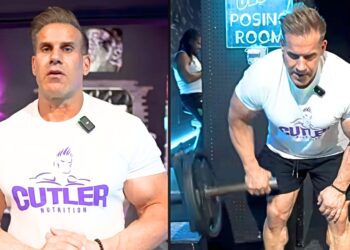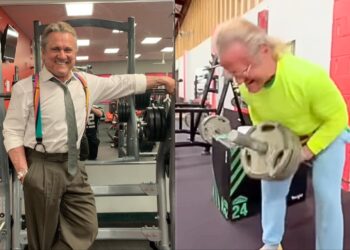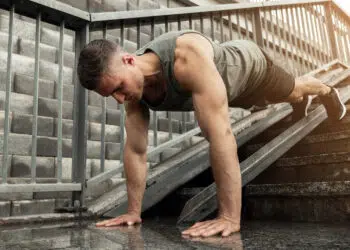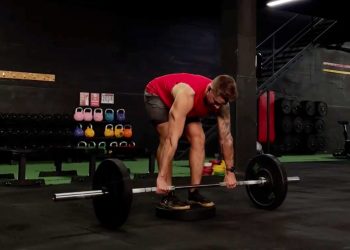John Meadows was a bodybuilder and physique coach known for his innovative and hardcore approach to lifting, which he called Mountain Dog Training. Meadows was always looking for ways to make standard bodybuilding exercises more effective.
Sadly, John Meadows passed away in 2021, dying of a pulmonary embolism in his sleep. He had a history of heart problems and is one of many prominent bodybuilders to pass away recently.
However, the Meadows bodybuilding legacy lives on in the form of the Meadows row. This unique back-builder is guaranteed to give you a thicker, more powerful-looking upper back.
In this article, we reveal why and how to do the Meadows row and the seven best exercises you can do instead.
Meadows Rows – Muscles Worked
Meadows rows are a compound exercise. This means they involve multiple muscles and joints working together. In a high-testosterone nutshell, Meadows rows work all your major and minor back muscles.
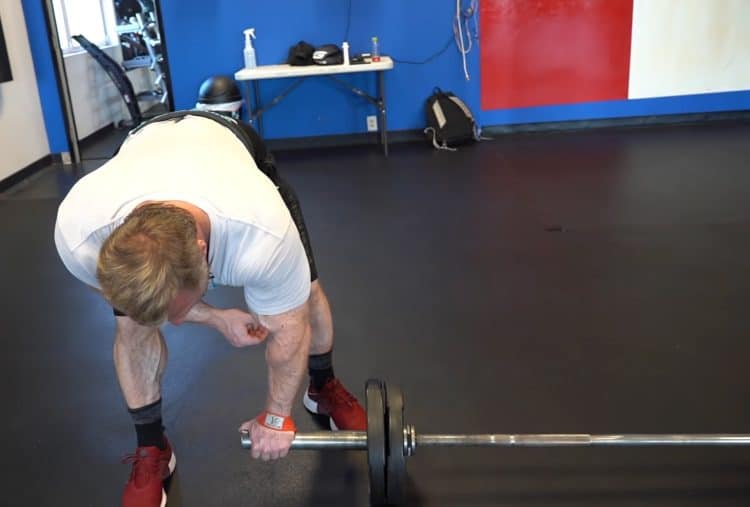
The most significant muscles trained during Meadows rows are:
Level Up Your Fitness: Join our 💪 strong community in Fitness Volt Newsletter. Get daily inspiration, expert-backed workouts, nutrition tips, the latest in strength sports, and the support you need to reach your goals. Subscribe for free!
Latissimus dorsi
Known as the lats for short, the latissimus dorsi is located on the side of your upper back. The functions of the lats are extension and adduction of the shoulder joint. When well-developed, the lats look a lot like large muscular wings. Meadows rows are a very effective latissimus dorsi exercise.
Trapezius
The trapezius or traps is a diamond shaped muscle located on your upper back. It is made up of three sets of fibers – upper, middle, and lower. The upper fibers are responsible for the elevation of your shoulders, while the lower fibers are responsible for depression. The middle fibers pull your shoulder blades back and together.
Meadows rows involve all three groups of fibers, but the mid-traps are the most active.
Rhomboids
Located between your shoulder blades, the rhomboids work with your middle trapezius to pull your shoulders together. This small muscle is critical for posture.
Deltoids
The deltoids are your most prominent and strongest shoulder muscles. There are three deltoid heads – anterior (front), medial (side) and posterior (rear).
The anterior head is responsible for shoulder flexion, whereas the medial deltoid head is responsible for the abduction of your arm. The posterior deltoid is on the back of your shoulder and is responsible for the extension of your arm. Th rear deltoid head is the most active during Meadows Rows, with the other two mostly working as stabilizers.
Biceps
The biceps are located on the front of your upper arm. Their primary function is flexion of your elbow joint. They also have a secondary role, which is the supination of your forearm. Despite being an upper back exercise, the Meadows row gives your biceps a great workout.
Core
Core is the collective term for the muscles of your midsection, including the rectus abdominis, obliques, transverse abdominis, and erector spinae. You’ll need a strong core to stabilize your lumbar spine during Meadows rows.
Additional muscles
The position of this exercise means you may feel Meadows rows in your legs, glutes, and lower back. This is normal, as these muscles must work hard to stabilize and support your upper body. However, the Meadows row is primarily an upper-back pulling exercise.
How to Do Meadows Rows
Get more from Meadows rows while keeping your risk of injury to a minimum by following these guidelines:
- Stand side-on to the end of a T-bar row machine or a landmine bar.
- Adopt a staggered stance so that your foot closest to the bar is placed to the rear.
- Hinge forward and hold the end of the bar with an overhand grip. Yes, this IS the thick end where the plates are loaded.
- Make sure your lower back is neutral. Brace your abs.
- Raise your hip that’s closest to the bar to put a stretch in your lat. This is the key to effective Meadows rows.
- Bend your arm and lift the weight, driving your elbow out and back to maximize lat engagement. Continue pulling until your elbow is behind your torso.
- Lower the weight down and repeat for the prescribed number of reps.
Check out this video to see the John Meadows himself demonstrating his namesake row:
Tips:
- Use lifting straps to enhance your grip and ensure your forearms don’t fatigue before your back. Alternatively, use lifting chalk to bolster your grip.
- Wear a weightlifting belt to support and protect your lower back.
- Start and finish each rep with the weight resting on the floor or avoid touching down between reps. Try both options to see which you prefer.
- Use small diameter plates so you can use the largest possible range of motion.
- Understand that unsupported forward flexion is not for everyone, and some people find this exercise uncomfortable and even painful. Skip the Meadows row if it hurts your lower back.
Meadows Rows Benefits
Not sure if Meadows rows deserve a place in your workouts? Consider these benefits and then make your decision!
A unique back exercise – Meadows rows hit your back from a very unusual angle. As such, they’re great for overcoming current training ruts and should reignite muscle growth. Bored of standard dumbbell rows? Meadows rows are the perfect solution!
Targets your lower lats – your lats are a long muscle, extending from your armpits down to near your waist. The lower lats are notoriously hard to develop. Meadows rows hit your lower lats hard, so you’ll finally be able to optimize your V-taper.
Improve your posture – the Meadows row is a horizontal pulling exercise that emphasizes your mid-traps, rhomboids, and posterior deltoids. These muscles work together to maintain good posture, pulling your shoulders back and together to reduce slouching. Good posture makes you look younger, slimmer, healthier, and more athletic.
Build a stronger grip – holding the thick end of a T-bar row will do wonders for your grip strength. However, you may still need to use lifting straps, especially if you’ve got short fingers.
Identify and correct left-to-right strength imbalances – it’s very common to have one arm and one side of your back stronger or more developed than the other. Small differences are nothing to lose sleep over, but more significant differences can be a problem. Unilateral exercises like Meadows rows are a great way to spot and fix left-to-right differences.
A functional exercise – Meadows rows work your legs, back, core, and arms at the same time. This means they’re a very functional exercise as these muscles often have to work together during non-gym activities.
Drawbacks
While Meadows rows are a mostly beneficial exercise, there are also a few drawbacks to consider:
Equipment – Meadows rows are best performed using a T-bar row. However, if you don’t have access to one, you can also use a landmine bar or just wedge one end of a barbell into a squat rack or the corner of your training room.
Lower back stress – there is no denying that Meadows rows put a lot of stress on your lower back. That’s inevitable with any exercise that involves unsupported forward flexion of the spine. However, providing you don’t go too heavy too soon, this stress will help strengthen your lower back and make it more resistant to fatigue. But, for some people, the Meadows row could cause back pain.
A tendency to cheat – it is all too easy to use your legs and lower back to help you lift the weight during Meadows rows. While this may allow you to use more weight or do a few more reps, you are basically cheating and taking work away from the muscles you want to target. You’ll need good body awareness and must leave your ego at the door to get the most from this exercise. Strict form will produce far better results and is also far safer.
Technical difficulty – the Meadows row is a technically demanding exercise that may be too tricky for beginners. Poor form can lead to injuries and will make your workout less effective. Only attempt Meadows rows if you can do exercises like seated cable and single-arm dumbbell rows correctly.
7 Meadows Rows Variations and Alternatives
Meadows rows are a highly effective back exercise, but that doesn’t mean you need to do them all the time. There are several variations and alternatives you can use to keep your workouts productive and interesting:
1. Single-arm dumbbell rows
If Meadows rows are a little too advanced for you right now, you can always do single-arm dumbbell rows instead. This popular exercise is one of the best ways to train one side of your back at a time, and all you need to do it is a dumbbell and a bench.
Level Up Your Fitness: Join our 💪 strong community in Fitness Volt Newsletter. Get daily inspiration, expert-backed workouts, nutrition tips, the latest in strength sports, and the support you need to reach your goals. Subscribe for free!
Steps:
- Place one hand and one knee on a flat exercise bench. Your lower back should be neutral and not rounded.
- Hold a dumbbell in your hand, with your palm facing inward, i.e., a neutral grip. Let your arm hang down from your shoulder. Pull your shoulder down and back, and brace your abs.
- Leading with your elbow, bend your arm and pull the dumbbell up and into your lower ribs. Keep your wrist straight.
- Extend your arm and repeat, taking care not to bounce out of the bottom of each rep.
- Complete the prescribed number of reps and then swap sides.
Muscles Targeted:
- Primary: Latissimus dorsi, mid-trapezius, rhomboids.
- Secondary: Posterior deltoids, biceps, forearms.
Benefits:
- Very little lower back stress.
- Less technically demanding than Meadows rows.
- An effective exercise for training one side of your back at a time.
Tips:
- Keep both feet on the floor for a more stable stance and to make it easier to keep your hips and shoulders level.
- Use a kettlebell instead of a dumbbell if preferred.
- Focus on leading with your elbow to maximize muscle recruitment. Imagine you are trying to elbow the ceiling above you.
2. Kroc rows
If you like single-arm dumbbell rows, you’ll LOVE Kroc rows. This exercise is single-arm rows on steroids! In regular single-arm rows, you keep your lower back and legs out of the movement to ensure that your arms and back do all the work. Kroc rows actually involve your legs and back, so you can lift heavier weights and do more reps. Think of Kroc rows as strategic cheating for a bigger, stronger back.
Steps:
- Hold a heavy dumbbell in one hand. Stand with your feet about shoulder-width apart and one foot in front of the other.
- Lean forward and place your free hand on a stable bench, dumbbell rack, or similar. Your shoulders should be higher than your hips.
- Brace your core and pull your shoulders down and back.
- Initiating the movement with your legs, pull the dumbbell up and into the side of your abdomen. Pull your shoulder back to maximally contract your upper back.
- Lower the weight, allowing your shoulder to flex forward at the bottom of each rep.
- Explode up again and repeat, trying not to pause between reps.
- Rest a moment and then do the same number of reps on the opposite side.
Muscles Targeted:
- Primary: Latissimus dorsi, mid-trapezius, rhomboids, core.
- Secondary: Posterior deltoids, biceps, forearms.
Benefits:
- Lift more weight or do more reps compared to standard single-arm dumbbell rows.
- Build full body strength – an excellent exercise for combat athletes, rugby, and football players.
- Improve your deadlift performance. Kroc rows were devised initially to be a deadlift assistance exercise.
Tips:
- Use lifting straps, so your forearms don’t fail before your back muscles.
- Wear a weightlifting belt to support and protect your lower back.
- Do 1-2 sets of high reps with a heavy weight – don’t leave any reps in the tank!
3. Bent-over dumbbell rows
It’s often more time efficient to train both sides of your body at the same time. The bent-over dumbbell row is more comfortable than the barbell version and a little more lower-back-friendly. Also, using dumbbells means you can work through a larger range of motion than the barbell version. However, like Meadows rows, there is still a significant load on your lower back.
Steps:
- Hold a dumbbell in each hand, arms by your sides, and hands facing your legs. Stand with your feet between shoulder and hip-width apart, knees slightly bent for stability.
- Pull your shoulders back and down and brace your core.
- Hinge from your hips and lean forward until your upper body is just above parallel to the ground. Let your arms hang down from your shoulders.
- Leading with your elbows and with straight wrists, bend your arms and pull the weights up and into your sides. Do not use your legs or lower back to help you lift the weights.
- Extend your arms and repeat.
Muscles Targeted:
- Primary: Latissimus dorsi, mid-trapezius, rhomboids, core.
- Secondary: Posterior deltoids, biceps, forearms.
Benefits:
- An excellent alternative to both Meadows rows and barbell bent-over rows.
- A good way to develop a stronger lower back and core.
- An effective but low-tech exercise that’s ideal for home lifters.
Tips:
- Adjust the angle of your torso to affect your back muscles in different ways.
- You can also do this exercise with an alternating arm action.
- Use an overhand grip for variety and to hit your back muscles from a different angle.
4. T-bar rows
T-bar rows are a traditional and very popular back-building exercise, and most gyms have a T-bar row machine. Most T-bar rows offer a choice of hand grips, so you can adopt whatever is most comfortable, and you feel most in your back muscles. Because of the angle of the lever arm and the position of the weight, T-bar rows are a little more lower-back-friendly than most other types of bent-over rows.
Steps:
- Step onto the T-bar row platform and stand astride the bar, feet between shoulder to hip-width apart.
- Bend your knees slightly and hinge forward from your hips, keeping your lower back slightly arched.
- Grasp the handles with both hands. With straight arms, stand up until your upper body is between 45 degrees and parallel to the floor.
- Bend your arms and pull the handle into your abs. Lead with your elbows, and keep your wrists straight. Do not round your lower back.
- Extend your arms and repeat.
Muscles Targeted:
- Primary: Latissimus dorsi, mid-trapezius, rhomboids, core.
- Secondary: Posterior deltoids, biceps, forearms.
Benefits:
- More lower back-friendly than most other bent-over row variations.
- A very effective lat and upper back builder.
- Most gyms have a T-bar row machine, and they can also be performed using a landmine device.
Tips:
- Keep your chest up and your shoulders down and back to maximize back engagement.
- NEVER round your lower back, as doing so can lead to severe back injuries.
- Use all the available grips (wide, narrow, neutral, etc.) to determine which works best for you.
5. Pendlay rows
Like the Meadows row, Pendlay rows are also named after a now-deceased strength training legend. In this case, we’re talking about USA weighting and powerlifting coach Glen Pendlay.
Also known as dead stop rows, this rowing variation starts and ends with the weight resting on the floor, which is a real lower back and grip saver that should allow you to lift heavier weights and do more reps compared to regular bent-over rows.
Steps:
- Place your barbell on the floor and stand behind it with your feet about hip to shoulder-width apart, toes under the bar.
- Bend your knees slightly, hinge forward from the hips, and grab the barbell with an overhand, just wider than shoulder-width grip. Your lower back should be slightly but tightly arched.
- Brace your core, squeeze your shoulder blades together, and then pull the bar up into your abdomen. Lead with your elbows, keeping your upper arms tucked in close to your sides and wrists straight. Your upper body should remain stationary throughout.
- Lower the barbell back down and let it settle on the floor. Reset your core and grip, and repeat.
Muscles Targeted:
- Primary: Latissimus dorsi, mid-trapezius, rhomboids, core.
- Secondary: Posterior deltoids, biceps, forearms.
Benefits:
- More lower-back and grip-friendly than traditional bent-over rows.
- No cheating, as each rep starts with the weight resting on the floor.
- An effective way to build power from a dead-stop; this is a very athletic exercise.
Tips:
- Raise the bar using larger diameter plates or a low platform if you cannot bend forward without rounding your lower back.
- You can also do this exercise with dumbbells instead of a barbell.
- Try single-arm Pendlay rows for variety and to make sure you aren’t using one arm more than the other.
6. Inverted rows
Things like dumbbells, barbells, and cable machines are a convenient way to train your muscles. However, there may be times when you don’t have access to equipment but still want to work out. The good news is that you can train most muscle groups with only your body weight for resistance. Inverted rows are a particularly effective upper back exercise.
Steps:
- Set the bar on a Smith machine or squat rack to around hip height. Sit on the floor below the bar and hold it with an overhand, shoulder-width grip.
- Lean back so your arms are straight, and then extend your legs in front of you. Lift your hips off the floor, so your weight rests only on your heels.
- Brace your core, and pull your shoulders back and down.
- Keeping your body straight, bend your elbows and pull your chest up, so it touches the bar.
- Extend your arms and repeat.
Muscles Targeted:
- Primary: Latissimus dorsi, mid-trapezius, rhomboids, core.
- Secondary: Posterior deltoids, biceps, forearms.
Benefits:
- Virtually no stress on your lower back.
- An excellent exercise for improving posture.
- Easy to scale up or down to suit all levels of strength and experience.
Tips:
- Place your feet on a bench to increase the weight on your arms.
- Raise the height of the bar to reduce the angle of your body and the weight on your arms.
- You can also do this exercise using gymnast rings or a suspension trainer, such as a TRX.
- Strap on a weighted vest for a more intense workout.
7. Single-arm cable rows
The great thing about most cable exercises is how they keep your muscles under near-constant tension. This means that some cable exercises are more effective than their freeweight counterparts.
This rowing variation allows you to train each side of your back in turn, but without overloading your lower back. Most people do cable rows with both arms, but using one arm at a time is arguably more effective.
Steps:
- Attach a D-shaped handle to a low pulley machine.
- Sit on the bench with your legs slightly bent and your upper body upright. Grip the handle in one hand.
- Pull your shoulders down and back, and brace your abs.
- Bend your arm and pull the handle back and into your lower ribs. Lead with your elbow, keep your arm close to your side, and maintain a straight wrist.
- Extend your arm, protract your shoulder slightly, pull it back again, and repeat.
- Do the same number of reps on both sides.
Muscles Targeted:
- Primary: Latissimus dorsi, mid-trapezius, rhomboids, core.
- Secondary: Posterior deltoids, biceps, forearms.
Benefits:
- A very joint-friendly exercise.
- Allows for a large yet safe range of motion.
- A good way to identify and fix left-to-right imbalances.
Tips:
- Experiment with an overhand, underhand, or neutral grip to see which you prefer.
- Use a rope handle or fat bar to increase forearm size and grip strength.
- You can also do this exercise standing instead of seated.
Meadows Rows – FAQs
Do you have a question about Meadows rows or back training in general? No worries because we’ve got the answers!
1. Are Meadows rows an effective back exercise?
John Meadows had a knack for discovering how to get the most from popular exercises. He also created several new movements, including the Meadows row, which quickly became bodybuilding staples.
Like most exercises named after famous bodybuilders, such as the Arnold press, Yates row, Zottman curl, and Hack squat, the Meadows row is both unique and effective. Used correctly, the Meadows deserves a place in your workouts and could definitely help you beef up your back.
2. How many reps and sets should I do with Meadows rows?
The Meadows row is a compound exercise that works well with heavy weights and low to moderate weights. However, to build muscle size, it’s generally best to do at least six reps per set, otherwise, you won’t produce enough metabolic stress to trigger hypertrophy.
That said, you can also build muscle with significantly higher reps so long as you take your sets close to failure. This means that anywhere from six to 30 reps should result in muscle growth.
You should be able to fatigue your muscles in 2-4 sets. If you feel like you can do more, you are not working hard enough or are resting too long between sets.
3. How many sets per week should I do for my back?
It’s generally accepted that muscles grow best when you do 10-20 hard sets per week. While you could do all of these sets in one workout, dividing them across two or more workouts is usually more effective.
Doing fewer sets per muscle group per workout allows you to train harder and heavier, producing better results.
So, instead of training to do all 20 sets for your back in a single workout, you could do two back workouts per week comprising three sets of three exercises. This would give you 18 sets per week, which is a good volume of training for most people.
4. Will Meadows rows make my back thicker or broader?
Generally speaking, vertical pulls (pull-ups, chin-ups, lat pulldowns) make your back wider, while horizontal pulls (seated rows, bent-over rows, lever rows) make it thicker. Because of this, most lifters should include vertical AND horizontal pulls in their workouts.
Meadows rows are a horizontal pulling exercise and, as such, are good for building back thickness. However, they’ll also make your lats wider, although pull-ups and pulldowns are usually better for this purpose.
5. Are Meadows rows safe?
Performed correctly, Meadows rows are pretty safe. However, if you round your lower back or use too much weight, there is a risk of injury. However, that can be said for almost every other exercise.
Meadows rows require you to lift one hip, which means you’ll put a slight asymmetric stress across your lower back. This could make Meadows rows a little riskier than other types of rowing exercise.
6. Which is better – Meadows rows or Kroc rows?
The answer to this is – it depends! When judging any two exercises, the best one is usually whichever matches your training goals. Both Meadows and Kroc rows are single-arm pulling exercises that target your entire back. However, where Meadows rows are done using a very precise technique, Kroc rows are more explosive and performed with very heavy weights.
The best way to decide between Meadows and Kroc rows is to try them both and see which one you prefer. Better still, put both these excellent exercises in your workouts and enjoy all the benefits they have to offer, e.g., Meadows rows on Monday and Kroc rows on Thursday.
7. Do I have to do Meadows rows?
Despite their popularity, Meadows rows are a relatively new exercise. Bodybuilders have been building their backs for decades before Meadows rows became a thing. As such, it’s safe to assume that they are NOT compulsory, and you can develop a strong, muscular back without Meadows rows. So, don’t do ‘em if you don’t like ‘em!
That said, the Meadows row is a unique exercise that could help you take your back development to the next level, so why not try them for a month or two and then see how you feel?
Still don’t like them after that? At least you will have given them a fair try.
Meadows Rows – Wrapping Up
Most bodybuilders have no problem naming long lists of chest and biceps exercises. However, when it comes to back training, their library of movements is usually much shorter.
That’s why so many workouts revolve around the same old lat pulldowns and seated rows and also why big, wide, muscular backs are so rare!
The Meadows row was invented by one of the godfathers of modern bodybuilding. As well as being an accomplished bodybuilder, John Meadows was also an influential coach and trainer of champions.
Take a leaf from the original Mountain Dog’s training book and add Meadows rows to your back workouts. This effective exercise will add slabs of muscle to your body and help you build lats, traps, and rhomboids you can be proud of.
Interested in measuring your progress? Check out our strength standards for Arnold Press, Pendlay Row, Pull Ups, and more.



